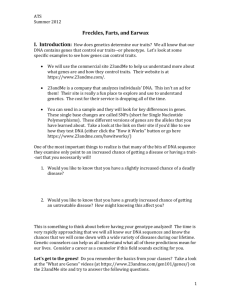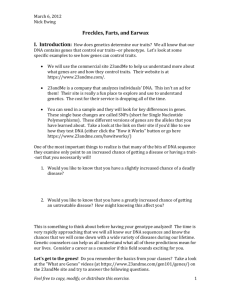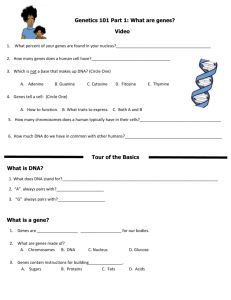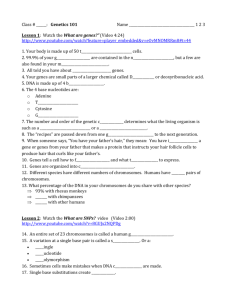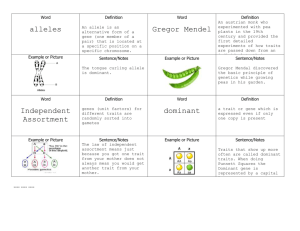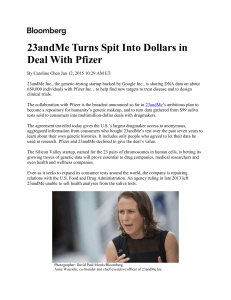Using Genetic Disease to Understand Genotype to Phenotype Or
advertisement
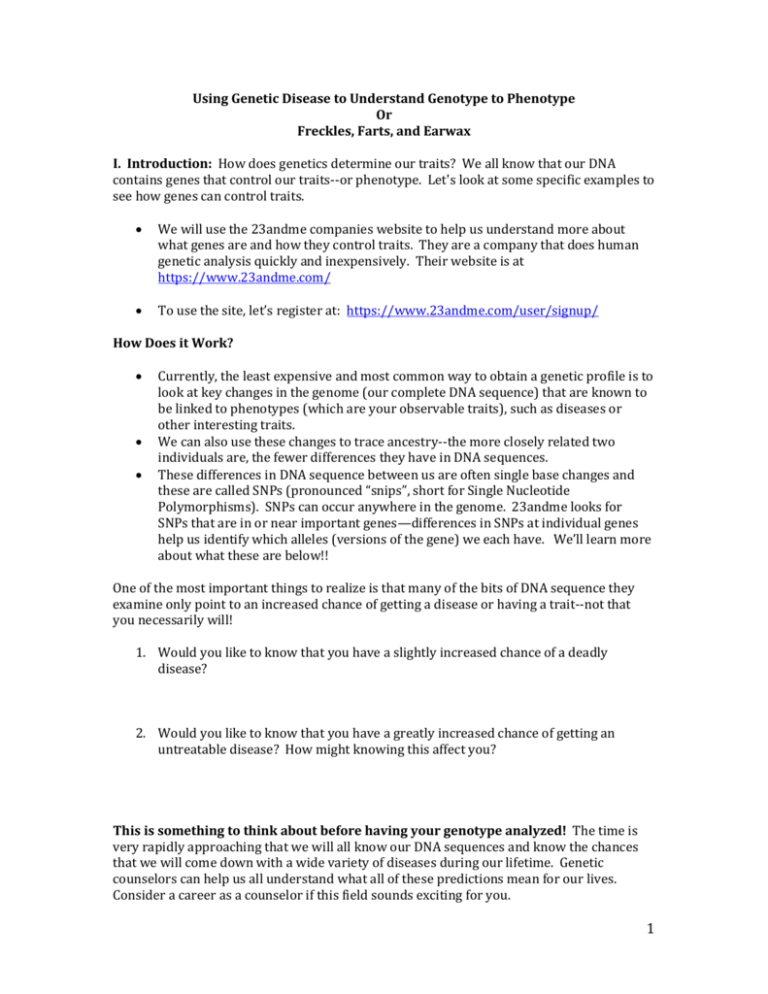
Using Genetic Disease to Understand Genotype to Phenotype Or Freckles, Farts, and Earwax I. Introduction: How does genetics determine our traits? We all know that our DNA contains genes that control our traits--or phenotype. Let's look at some specific examples to see how genes can control traits. We will use the 23andme companies website to help us understand more about what genes are and how they control traits. They are a company that does human genetic analysis quickly and inexpensively. Their website is at https://www.23andme.com/ To use the site, let’s register at: https://www.23andme.com/user/signup/ How Does it Work? Currently, the least expensive and most common way to obtain a genetic profile is to look at key changes in the genome (our complete DNA sequence) that are known to be linked to phenotypes (which are your observable traits), such as diseases or other interesting traits. We can also use these changes to trace ancestry--the more closely related two individuals are, the fewer differences they have in DNA sequences. These differences in DNA sequence between us are often single base changes and these are called SNPs (pronounced “snips”, short for Single Nucleotide Polymorphisms). SNPs can occur anywhere in the genome. 23andme looks for SNPs that are in or near important genes—differences in SNPs at individual genes help us identify which alleles (versions of the gene) we each have. We’ll learn more about what these are below!! One of the most important things to realize is that many of the bits of DNA sequence they examine only point to an increased chance of getting a disease or having a trait--not that you necessarily will! 1. Would you like to know that you have a slightly increased chance of a deadly disease? 2. Would you like to know that you have a greatly increased chance of getting an untreatable disease? How might knowing this affect you? This is something to think about before having your genotype analyzed! The time is very rapidly approaching that we will all know our DNA sequences and know the chances that we will come down with a wide variety of diseases during our lifetime. Genetic counselors can help us all understand what all of these predictions mean for our lives. Consider a career as a counselor if this field sounds exciting for you. 1 Let's get to the genes! Let’s take a look at the "What are Genes" video on the 23andMe site and try to answer the following questions. The video is located at https://www.23andme.com/gen101/genes/, or it can also be found under “Featured Content” on the welcome page if you’re logged in. 3. How many genes do the 23andMe folks say that we have? (Their number may be a bit low.) 4. How long is all of the DNA in a single cell? 5. What percentage of our DNA do we share with the rhesus monkey? Chimpanzees? 6. What percentage of our DNA sequences do we share with other humans? 7. All of our nucleated cells have the same DNA. What makes cells different from each other? (Hint: are all genes on all of the time?) II. How do genes control heredity? DNA RNA protein We have one set of chromosomes for our mom and one from our dad. RNA molecules are copied from the parts of our DNA that are genes (much of our DNA isn’t genes). This process is called transcription and we say RNA is transcribed from DNA. RNA is the same type of molecule as DNA—they both are nucleic acids and are each composed of four nucleotides. These are the letters of the genetic code!! ACG and T are the four nucleotides (also called bases) in DNA and ACG and U are the four in RNA. RNA copies are translated by ribosomes that use the RNA sequence to produce proteins based on the RNA sequence code. We call this translation because it is changed from the language of nucleic acids to the language of proteins. Ribosomes read the DNA sequence in codons that consist of three nucleotides. Codons specify the amino acid that is added to the growing protein by the ribosome. There are codons that tell the ribosome where to start (AUG) and where to stop (TAA, TAG and TGA). The genetic code is shown on the last page of this handout. It is the RNA and proteins encoded in our DNA that make us what we are! It is slight differences in our DNA sequences that make us different. Many of the differences between humans are changes in a single base—that is, a single letter of the code is different. These are the Single Nucleotide Polymorphisms, or SNPs for short, that are mentioned above. These SNPs (pronounced snips) can be in or near a gene and they often show us 2 what traits we will have. It is relatively easy to determine what our individual sequences are at very many of our SNPs—this is our genotype. For example, 23andme surveys many of our SNPs for just $100. Very soon we will be able to get the entire sequence of our genome for not much more than that! Here is a video at 23andme explaining more about SNPs: https://www.23andme.com/gen101/snps/ Let’s take a look. Now is a good time to try to find SNPs and see how they can affect proteins: Here are sequences of a short part of a gene: AUG GUG CUG UCU CCU GCC GAC AAG ACC AAC GUC UAG GCC GCC AUG GUG CUU UCU CCU GCC GAA AAG ACC AAC GUC AAG GCC GCC 8. Is this an mRNA molecule or DNA molecule? How can you tell? 9. How many SNPs can you can find in this segment? Circle those. 10. Use the genetic code at the end of this handout to translate this sequence into amino acid sequence. Fill in the correct amino acid below each codon above. 11. What affect does each SNP have on the protein sequence? Do you think these will affect the protein’s function? Why? III. Let’s look at some examples of how genes and SNPs determine our traits: Earwax...hey, get your finger out of your ear! Have you noticed what your earwax is like? There are two major types of earwax, moist and dry. The 23andMe site describes some of the biology and genetics behind earwax. You do need to be logged in to view Health Reports. From the welcome page once logged in, click on “My Results” at the top of the page and then on “Traits” in the dropdown menu. Next scroll down to “Earwax Type” 3 Here is some of the genetic info: The genotype column shows the nucleotides at a single position in our DNA. This is a site that has been identified to be important for this trait for which our sequences differ. Since these genes differ at this site these are different alleles. These are examples of single base changes (Single Nucleotide Polymorphism or SNPs). The “What it Means” column shows the expected phenotype. 12. The genotype that is shown represents the sequence at a single base in our DNA. Two bases are shown for this site (C or T). Why are there two bases listed as the genotype? 13. So, these SNPs represent two different alleles of this gene. Think about Mendel's experiments (Gregor Mendel...not Greg Mendel whose genotype is given here.) Which of these alleles is dominant? Why do you conclude that? 14. Can you think of how earwax might be made by your body? Write at least one possible explanation here (hint: it is made inside cells first before it ends up in your ear canal). 15. If a material such as earwax is made in a cell it needs to somehow get across the cell membrane. Do you know some of the ways in which cells move materials across membranes? Describe how this could occur. 4 16. If you scroll down a bit to “Learn More About ABCC11” you can see that the SNP here is in the gene ABCC11. This gene encodes a protein that pumps materials across membranes. In this case, it pumps some of the material in earwax across membranes. The single base change of this SNP is in the region of the gene that codes for the protein and causes an amino acid change from glycine to arginine. Can changing just one amino acid have a dramatic effect on a protein's function? Do you think changing any one amino acid would necessarily have a big effect? Explain why you conclude this. 17. If the whole ABCC11 protein is 1380 amino acids, at least how long must the mRNA be? (Show your calculations.) The SNP is at base 538 of the mRNA. At this site the sequence is either a G or an A on the coding strand but the 23andMe site shows the SNP as a C or T because 23andMe reports the sequence of the complementary strand. 18. Look at the genetic code on the last page of this handout. Could a single G to A change cause a change from Glycine (abbreviated Gly or G) to Arginine (Arg or R)? Which base of the codon must this be? IV. Taste Blindness! It probably is not surprising that we differ in our ability to taste. These differences are probably a big part of why we like different foods. Take a look at the Traits list and find “Bitter Taste Perception”. 19. What does the gene code for? 20. If individuals have two of the bad alleles they have an 80% chance of not tasting bitterness. Considering what the gene codes for can you propose an explanation for why we have to have two bad copies of this gene to not be able to taste? 5 21. Would Mendel consider the allele that allows one to taste bitter compounds to be a dominant allele? 22. What is a possible evolutionary advantage of being able to taste bitter compounds? 23. (Optional) If you want to learn more read, on in the section below: Learn More About TAS2R38. Here are a couple of questions to think about from that section: a. Might there be an advantage to having the taste-blind allele? b. What might be the advantage of having the taste-blind allele and the normal allele? V. Freckles: Let's take a look at a bit of the biology behind freckling. Go to “Freckling” under “Traits” in the “My Results” section. 24. How many different genes do they examine for this trait? 25. Does any one of these genes control this trait completely? 26. The two traits we looked at above (earwax type and taste-blindness) are largely determined by genetics. Many traits are affected by the environment and not just determined by genetics. Do you think freckles may have a big contribution from the environment also? 6 VI. Farts...oops, safety! Do you like ice cream...but does it not like you? Many people are not able to digest lactose. Take a look at the page on lactose intolerance under “Traits” in the “My Results” section. This is an interesting example that adds some new twists. 27. What enzyme do we all produce as babies to digest lactose? (About 40% of the total calories in breast milk is from lactose.) 28. People who can digest lactose as adults continue to produce this enzyme. The ability to produce the enzyme is determined by genetics. Look at the panel "Understanding your Results". How can the environment affect this phenotype? 29. In the previous examples some of the SNPs were in the coding regions of genes. The SNPs identified here aren't in the coding region, but are near by. How can mutations near a gene affect whether or not the protein is made. . VII. Don’t Give Me a Heart Attack! 30. Do you think that there is an environmental component to heart disease? If yes, what are some examples of how the environment or behavior can affect heart disease? 31. Do you think that your genes have an effect on the chance you will develop heart disease? 32. Open up “Click on Results”, then “Health Risks”, and the “Coronary Heart Disease”. Compare the results for Greg Mendel and for Lily Mendel. Is there a genetic component? 33. Look in Understanding your Results on the same webpage to see the genetic contribution along with a list of the environmental factors that can have an affect heart disease. 7 34. Scroll down to the “Marker Effects” graph. What do each of the bars and their color and height represent? VII. What is a Phenotype? OK, we’ve been looking at genes and some to the SNPs in them. Our DNA sequence is our genotype. What is our phenotype? Let’s check out another video: https://www.23andme.com/gen101/ 35. So, what is a phenotype? 36. Is your phenotype determined only by your genotype? (Think back to the examples we have seen above.) Were some of the phenotypes we looked at above controlled more by your genes than others? VIII. Ancestry…where did I come from? Let’s take a look at 23andme’s video: “Where do your genes come from?” https://www.23andme.com/gen101/origins/ 37. Why do we have two copies of most chromosomes? 38. What are matching pairs of chromosomes called? 39. What is different about X and Y chromosomes? 40. What are mitochondria? Did you know if they have DNA also? 8 41. Why would mitochondria have DNA? (This isn’t in the video!!) We inherit our mitochondria from our mother so we can use it to trace our maternal lineage by comparing SNPs between mitochondrial sequences. Go back to the sample genotypes of the Mendels at 23andme. Click on “My Results” and then “Maternal Line” to see the Mendel’s mitochondrial type (or haplotype). Explore the links here. 42. What percentage of their genes are of Neanderthal origin? 43. What is their most likely ancestry? There are many interesting links at 23andMe: For a fun look at some other really interesting the links between genes and disease click on "Discoveries" on the 23andMe homepage or go to: https://www.23andme.com/about/factoids/ Under the “my results” section you’ll find tons of information on many different traits, diseases, responses to drugs and more. Lots more good stuff if you look around their site. 9 The Genetic Code: Image from: Godfrey-Smith, Peter and Sterelny, Kim, "Biological Information", The Stanford Encyclopedia of Philosophy (Fall 2008 Edition), Edward N. Zalta (ed.), URL = <http://plato.stanford.edu/archives/fall2008/entries/information-biological/>, accessed Feb. 27, 2012 10
